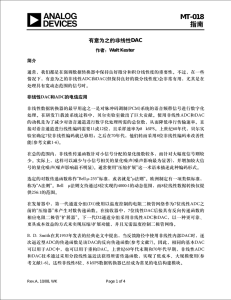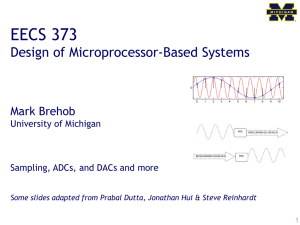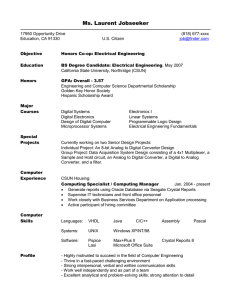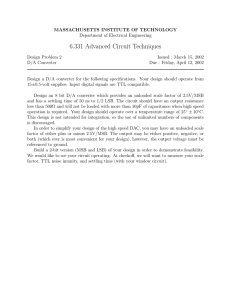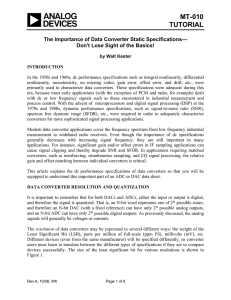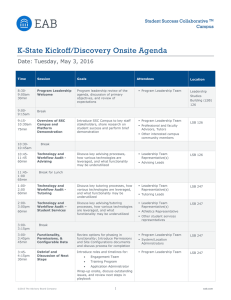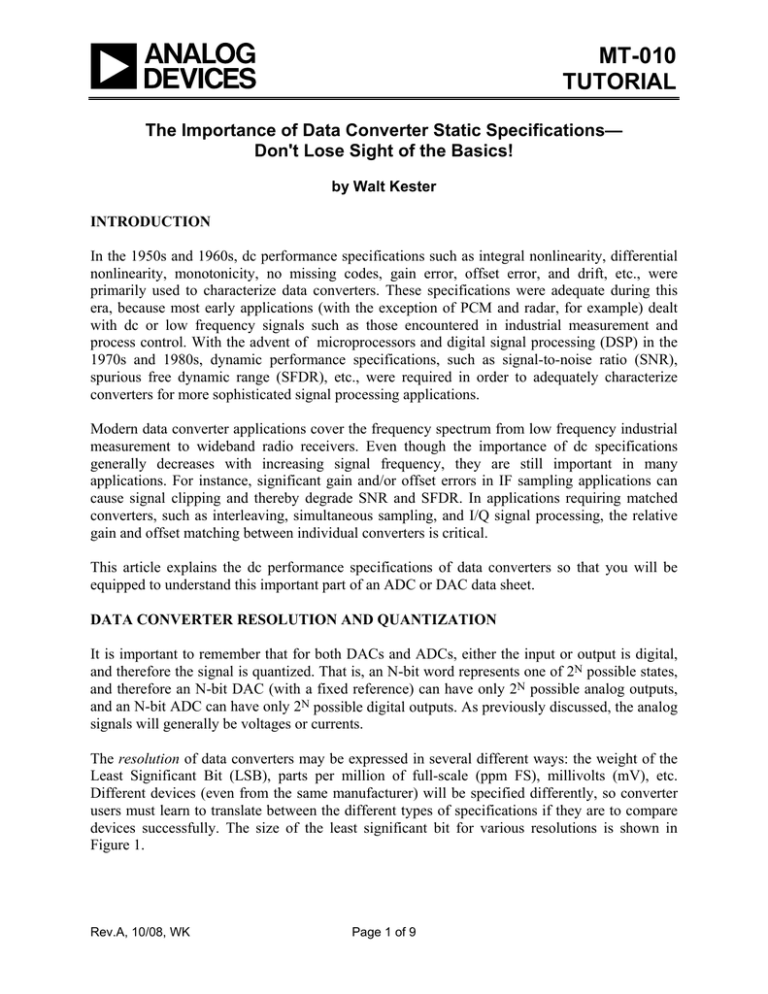
MT-010
TUTORIAL
The Importance of Data Converter Static Specifications—
Don't Lose Sight of the Basics!
by Walt Kester
INTRODUCTION
In the 1950s and 1960s, dc performance specifications such as integral nonlinearity, differential
nonlinearity, monotonicity, no missing codes, gain error, offset error, and drift, etc., were
primarily used to characterize data converters. These specifications were adequate during this
era, because most early applications (with the exception of PCM and radar, for example) dealt
with dc or low frequency signals such as those encountered in industrial measurement and
process control. With the advent of microprocessors and digital signal processing (DSP) in the
1970s and 1980s, dynamic performance specifications, such as signal-to-noise ratio (SNR),
spurious free dynamic range (SFDR), etc., were required in order to adequately characterize
converters for more sophisticated signal processing applications.
Modern data converter applications cover the frequency spectrum from low frequency industrial
measurement to wideband radio receivers. Even though the importance of dc specifications
generally decreases with increasing signal frequency, they are still important in many
applications. For instance, significant gain and/or offset errors in IF sampling applications can
cause signal clipping and thereby degrade SNR and SFDR. In applications requiring matched
converters, such as interleaving, simultaneous sampling, and I/Q signal processing, the relative
gain and offset matching between individual converters is critical.
This article explains the dc performance specifications of data converters so that you will be
equipped to understand this important part of an ADC or DAC data sheet.
DATA CONVERTER RESOLUTION AND QUANTIZATION
It is important to remember that for both DACs and ADCs, either the input or output is digital,
and therefore the signal is quantized. That is, an N-bit word represents one of 2N possible states,
and therefore an N-bit DAC (with a fixed reference) can have only 2N possible analog outputs,
and an N-bit ADC can have only 2N possible digital outputs. As previously discussed, the analog
signals will generally be voltages or currents.
The resolution of data converters may be expressed in several different ways: the weight of the
Least Significant Bit (LSB), parts per million of full-scale (ppm FS), millivolts (mV), etc.
Different devices (even from the same manufacturer) will be specified differently, so converter
users must learn to translate between the different types of specifications if they are to compare
devices successfully. The size of the least significant bit for various resolutions is shown in
Figure 1.
Rev.A, 10/08, WK
Page 1 of 9
MT-010
RESOLUTION
N
VOLTAGE
(10V FS)
ppm FS
% FS
dB FS
2N
2-bit
4
2.5 V
250,000
25
– 12
4-bit
16
625 mV
62,500
6.25
– 24
6-bit
64
156 mV
15,625
1.56
– 36
8-bit
256
39.1 mV
3,906
0.39
– 48
10-bit
1,024
9.77 mV (10 mV)
977
0.098
– 60
12-bit
4,096
2.44 mV
244
0.024
– 72
14-bit
16,384
610 μV
61
0.0061
– 84
16-bit
65,536
153 μV
15
0.0015
– 96
18-bit
262,144
38 μV
4
0.0004
– 108
20-bit
1,048,576
9.54 μV (10 μV)
1
0.0001
– 120
22-bit
4,194,304
2.38 μV
0.24
0.000024
– 132
24-bit
16,777,216
596 nV*
0.06
0.000006
– 144
*600nV is the Johnson Noise in a 10kHz BW of a 2.2kΩ Resistor @ 25°C
Remember: 10-bits and 10V FS yields an LSB of 10mV, 1000ppm, or 0.1%.
All other values may be calculated by powers of 2.
Figure 1: Quantization: The Size of a Least Significant Bit (LSB)
TRANSFER FUNCTIONS OF IDEAL DATA CONVERTERS
Figure 2 shows the ideal transfer characteristics for a 3-bit unipolar DAC and a 3-bit unipolar
ADC. In a DAC, both the input and the output are quantized, and the graph consists of eight
points—while it is reasonable to discuss the line through these points, it is very important to
remember that the actual transfer characteristic is not a line, but a number of discrete points.
DAC
ADC
FS
111
110
DIGITAL 101
OUTPUT
ANALOG
OUTPUT
100
011
QUANTIZATION
UNCERTAINTY
010
QUANTIZATION
UNCERTAINTY
001
000
000
001
010
011
100
101
110
111
ANALOG INPUT
FS
DIGITAL INPUT
Figure 2: Transfer Functions for Ideal 3-Bit DAC and ADC
The input to an ADC is analog and is not quantized, but its output is quantized. The transfer
characteristic therefore consists of eight horizontal steps. When considering the offset, gain and
Page 2 of 9
MT-010
linearity of an ADC we consider the line joining the midpoints of these steps—often referred to
as the code centers.
For both DACs and ADCs, digital full-scale (all "1"s) corresponds to 1 LSB below the analog
full-scale (FS). The (ideal) ADC transitions take place at ½ LSB above zero, and thereafter every
LSB, until 1½ LSB below analog full-scale. Since the analog input to an ADC can take any
value, but the digital output is quantized, there may be a difference of up to ½ LSB between the
actual analog input and the exact value of the digital output. This is known as the quantization
error or quantization uncertainty also shown in Figure 2. In ac (sampling) applications this
quantization error gives rise to quantization noise which is discussed in detail in other articles.
There are many possible digital coding schemes for data converters: straight binary, offset
binary, 1's complement, 2's complement, sign magnitude, gray code, BCD and others. This
article, being devoted mainly to the analog issues surrounding data converters, will use simple
binary and offset binary in its examples and will not consider the merits and disadvantages of
these, or any other forms of digital code. For more details on data converter coding, refer to
References 1 and 2.
The examples in Figure 2 use unipolar converters, whose analog port has only a single polarity.
These are the simplest type, but bipolar converters are generally more useful in real-world
applications. There are two types of bipolar converters: the simpler is merely a unipolar
converter with an accurate 1 MSB of negative offset (and many converters are arranged so that
this offset may be switched in and out so that they can be used as either unipolar or bipolar
converters at will), but the other, known as a sign-magnitude converter is more complex, and has
N bits of magnitude information and an additional bit which corresponds to the sign of the
analog signal. Sign-magnitude DACs are quite rare, and sign-magnitude ADCs are found mostly
in digital voltmeters (DVMs). The unipolar, offset binary, and sign-magnitude representations
are shown in Figure 3.
UNIPOLAR
OFFSET BIPOLAR
FS – 1 LSB
FS – 1 LSB
0
SIGN MAGNITUDE
BIPOLAR
CODE
FS – 1 LSB
CODE
0
CODE
0
ALL
"1"s
ALL
"1"s
1 AND ALL "0"s
–FS
–(FS – 1 LSB)
Figure 3: Unipolar and Bipolar Converters
Page 3 of 9
MT-010
DATA CONVERTER GAIN AND OFFSET ERRORS
The four dc errors in a data converter are offset error, gain error, and two types of linearity error
(differential and integral). Offset and gain errors are analogous to offset and gain errors in
amplifiers as shown in Figure 4 for a bipolar input range. (Though offset error and zero error,
which are identical in amplifiers and unipolar data converters, are not identical in bipolar
converters and should be carefully distinguished.)
+FS
+FS
ACTUAL
ACTUAL
IDEAL
IDEAL
0
0
ZERO ERROR
OFFSET
ERROR
ZERO ERROR
NO GAIN ERROR:
ZERO ERROR = OFFSET ERROR
–FS
–FS
WITH GAIN ERROR:
OFFSET ERROR = 0
ZERO ERROR RESULTS
FROM GAIN ERROR
Figure 4: Bipolar Data Converter Offset and Gain Error
The transfer characteristics of both DACs and ADCs may be expressed as a straight line given by
D = K + GA, where D is the digital code, A is the analog signal, and K and G are constants. In a
unipolar converter, the ideal value of K is zero; in an offset bipolar converter it is –1 MSB. The
offset error is the amount by which the actual value of K differs from its ideal value.
The gain error is the amount by which G differs from its ideal value, and is generally expressed
as the percentage difference between the two, although it may be defined as the gain error
contribution (in mV or LSB) to the total error at full-scale. These errors can usually be trimmed
by the data converter user. Note, however, that amplifier offset is trimmed at zero input, and then
the gain is trimmed near to full-scale. The trim algorithm for a bipolar data converter is not so
straightforward.
DATA CONVERTER LINEARITY ERRORS
The integral linearity error of a converter is also analogous to the linearity error of an amplifier,
and is defined as the maximum deviation of the actual transfer characteristic of the converter
from a straight line, and is generally expressed as a percentage of full-scale (but may be given in
LSBs). For an ADC, the most popular convention is to draw the straight line through the mid-
Page 4 of 9
MT-010
points of the codes, or the code centers. There are two common ways of choosing the straight
line: end point and best straight line as shown in Figure 5.
END POINT METHOD
BEST STRAIGHT LINE METHOD
OUTPUT
LINEARITY
ERROR = X
INPUT
LINEARITY
ERROR ≈ X/2
INPUT
Figure 5: Method of Measuring Integral Linearity Errors
(Same Converter on Both Graphs)
In the end point system, the deviation is measured from the straight line through the origin and
the full-scale point (after gain adjustment). This is the most useful integral linearity measurement
for measurement and control applications of data converters (since error budgets depend on
deviation from the ideal transfer characteristic, not from some arbitrary "best fit"), and is the one
normally adopted by Analog Devices, Inc.
The best straight line, however, does give a better prediction of distortion in ac applications, and
also gives a lower value of "linearity error" on a data sheet. The best fit straight line is drawn
through the transfer characteristic of the device using standard curve fitting techniques, and the
maximum deviation is measured from this line. In general, the integral linearity error measured
in this way is only 50% of the value measured by end point methods. This makes the method
good for producing impressive data sheets, but it is less useful for error budget analysis. For ac
applications it is better to specify distortion than dc linearity, so it is rarely necessary to use the
best straight line method to define converter linearity.
The other type of converter nonlinearity is differential nonlinearity (DNL). This relates to the
linearity of the code transitions of the converter. In the ideal case, a change of 1 LSB in digital
code corresponds to a change of exactly 1 LSB of analog signal. In a DAC, a change of 1 LSB in
digital code produces exactly 1 LSB change of analog output, while in an ADC there should be
exactly 1 LSB change of analog input to move from one digital transition to the next. Differential
linearity error is defined as the maximum amount of deviation of any quantum (or LSB change)
in the entire transfer function from its ideal size of 1 LSB.
Where the change in analog signal corresponding to 1 LSB digital change is more or less than
1 LSB, there is said to be a DNL error. The DNL error of a converter is normally defined as the
maximum value of DNL to be found at any transition across the range of the converter. Figure 6
shows the non-ideal transfer functions for a DAC and an ADC and shows the effects of the DNL
error.
Page 5 of 9
MT-010
DAC
ADC
FS
111
110
ANALOG
OUTPUT
DIGITAL 101
OUTPUT
100
MISSING CODE
011
NON-MONOTONIC
010
001
000
000
001
010
011
100
101
110
ANALOG INPUT
111
FS
DIGITAL INPUT
Figure 6: Transfer Functions for Non-Ideal 3-Bit DAC and ADC
The DNL of a DAC is examined more closely in Figure 7. If the DNL of a DAC is less than –1
LSB at any transition, the DAC is non-monotonic i.e., its transfer characteristic contains one or
more localized maxima or minima. A DNL greater than +1 LSB does not cause nonmonotonicity, but is still undesirable. In many DAC applications (especially closed-loop systems
where non-monotonicity can change negative feedback to positive feedback), it is critically
important that DACs are monotonic. DAC monotonicity is often explicitly specified on data
sheets, although if the DNL is guaranteed to be less than 1 LSB (i.e., |DNL| ≤ 1 LSB) then the
device must be monotonic, even without an explicit guarantee.
FS
d
1 LSB,
DNL = 0
BIT 2 IS 1 LSB HIGH
BIT 1 IS 1 LSB LOW
2 LSB,
DNL = +1 LSB
ANALOG
OUTPUT
1 LSB,
DNL = 0
–1 LSB,
DNL = –2 LSB
1 LSB,
DNL = 0
2 LSB,
DNL = +1 LSB
NON-MONOTONIC IF
DNL < –1 LSB
1 LSB,
DNL = 0
d
000
001
010 011
100 101 110
DIGITAL CODE INPUT
111
Figure 7: Details of DAC Differential Nonlinearity
Page 6 of 9
MT-010
In Figure 8, the DNL of an ADC is examined more closely on an expanded scale. ADCs can be
non-monotonic, but a more common result of excess DNL in ADCs is missing codes. Missing
codes in an ADC are as objectionable as non-monotonicity in a DAC. Again, they result from
DNL < –1 LSB.
MISSING CODE (DNL < –1 LSB)
DIGITAL
OUTPUT
CODE
1 LSB,
DNL = 0
0.25 LSB,
DNL = –0.75 LSB
1.5 LSB,
DNL = +0.5 LSB
0.5 LSB,
DNL = –0.5 LSB
1 LSB,
DNL = 0
ANALOG INPUT
Figure 8: Details of ADC Differential Nonlinearity
Not only can ADCs have missing codes, they can also be non-monotonic as shown in Figure 9.
As in the case of DACs, this can present major problems—especially in servo applications.
MISSING CODE
DIGITAL
OUTPUT
CODE
NON-MONOTONIC
ANALOG INPUT
Figure 9: Non-Monotonic ADC with Missing Code
Page 7 of 9
MT-010
In a DAC, there can be no missing codes—each digital input word will produce a corresponding
analog output. However, DACs can be non-monotonic as previously discussed. In a straight
binary DAC, the most likely place a non-monotonic condition can develop is at mid-scale
between the two codes: 011…11 and 100…00. If a non-monotonic conditions occurs here, it is
generally because the DAC is not properly calibrated or trimmed. A successive approximation
ADC with an internal non-monotonic DAC will generally produce missing codes but remain
monotonic. However it is possible for an ADC to be non-monotonic—again depending on the
particular conversion architecture. Figure 9 shows the transfer function of an ADC which is nonmonotonic and has a missing code.
ADCs which use the subranging architecture divide the input range into a number of coarse
segments, and each coarse segment is further divided into smaller segments—and ultimately the
final code is derived. This process is described in more detail in Chapter 4 of this book. An
improperly trimmed subranging ADC may exhibit non-monotonicity, wide codes, or missing
codes at the subranging points as shown in Figure 10A, B, and C, respectively. This type of ADC
should be trimmed so that drift due to aging or temperature produces wide codes at the sensitive
points rather than non-monotonic or missing codes.
(A) NON-MONOTONIC
(B) WIDE CODES
(C) MISSING CODES
NON-MONOTONIC
MISSING
CODE
WIDE
CODE
NON-MONOTONIC
MISSING
CODE
WIDE
CODE
ANALOG INPUT
Figure 10: Errors Associated with Improperly Trimmed Subranging ADC
Defining missing codes is more difficult than defining non-monotonicity. All ADCs suffer from
some inherent transition noise as shown in Figure 11 (think of it as the flicker between adjacent
values of the last digit of a DVM). As resolutions and bandwidths become higher, the range of
input over which transition noise occurs may approach, or even exceed, 1 LSB. High resolution
wideband ADCs generally have internal noise sources which can be reflected to the input as
effective input noise summed with the signal. The effect of this noise, especially if combined
Page 8 of 9
MT-010
with a negative DNL error, may be that there are some (or even all) codes where transition noise
is present for the whole range of inputs. There are therefore some codes for which there is no
input which will guarantee that code as an output, although there may be a range of inputs which
will sometimes produce that code.
CODE TRANSITION NOISE
DNL
TRANSITION NOISE
AND DNL
ADC
OUTPUT
CODE
ADC INPUT
ADC INPUT
ADC INPUT
Figure 11: Combined Effects of Code Transition Noise and DNL
For low resolution ADCs, it may be reasonable to define no missing codes as a combination of
transition noise and DNL which guarantees some level (perhaps 0.2 LSB) of noise-free code for
all codes. However, this is impossible to achieve at the very high resolutions achieved by modern
sigma-delta ADCs, or even at lower resolutions in wide bandwidth sampling ADCs. In these
cases, the manufacturer must define noise levels and resolution in some other way. Which
method is used is less important, but the data sheet should contain a clear definition of the
method used and the performance to be expected. A complete discussion of effective input noise
is given in References 2 and 3.
REFERENCES:
1.
Dan Sheingold, Analog-Digital Conversion Handbook, 3rd Edition, Analog Devices and Prentice-Hall,
1986, ISBN-0-13-032848-0. (the defining and classic book on data conversion).
2.
Walt Kester, Analog-Digital Conversion, Analog Devices, 2004, ISBN 0-916550-27-3, Chapter 2 and 5.
Also available as The Data Conversion Handbook, Elsevier/Newnes, 2005, ISBN 0-7506-7841-0, Chapters
2 and 5.
3.
Walt Kester, "The Good, the Bad, and the Ugly Aspects of ADC Input Noise: Is No Noise Good Noise?"
Tutorial MT-004, Analog Devices.
Copyright 2009, Analog Devices, Inc. All rights reserved. Analog Devices assumes no responsibility for customer
product design or the use or application of customers’ products or for any infringements of patents or rights of others
which may result from Analog Devices assistance. All trademarks and logos are property of their respective holders.
Information furnished by Analog Devices applications and development tools engineers is believed to be accurate
and reliable, however no responsibility is assumed by Analog Devices regarding technical accuracy and topicality of
the content provided in Analog Devices Tutorials.
Page 9 of 9

